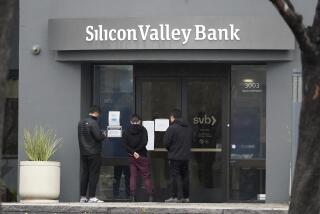Driven by Trends : Computer Industry Puts Byte on Vulnerable Disk-Drive Makers
- Share via
Few businesses seem to enjoy prosperity for shorter periods than the makers of hard-disk drives, the box-like devices that allow computers to read and write data magnetically on rigid disks.
Just when a model is selling well and healthy profits are being made, computer makers demand more compact versions or increasingly sophisticated drives that store more data and retrieve it faster. Hot products can become old news quickly. Glitches can develop when companies try to boost performance. Through it all, disk-drive makers are perilously at the mercy of the health of the computer industry at large.
Three years ago, much of the country’s disk-drive business was based in office parks in Chatsworth, where such industry leaders as Tandon Corp., Computer Memories and Micropolis Corp. had headquarters.
Today, only Micropolis remains. Computer Memories auctioned off most of its assets after IBM stopped buying its products. Tandon sold its struggling disk-drive operations to emphasize building personal computers, and moved west to Moorpark.
“This industry has extreme peaks and valleys. Its product lives are short, and it’s difficult to get into new products,” said James N. Porter, who tracks the industry as president of Disk/Trend, a market research firm in Mountain View.
Three of the industry’s leading independent companies--Micropolis, Seagate Technology in Scotts Valley, and Maxtor Corp. in San Jose--are struggling. Yet others are doing well, among them Miniscribe Corp. in Longmont, Colo., Quantum Corp. in Milpitas and fast-growing Conner Peripherals of San Jose.
Micropolis has had its problems ironing out manufacturing problems in its more sophisticated drives. Costs to make the company’s newer 380-megabyte drive have been unexpectedly high. (A megabyte is a basic unit of computer information. The latest Micropolis model is capable of storing up to 380 million bytes.) The company only recently was able to move the manufacturing of the disk drive to Singapore, where costs are much cheaper than in Chatsworth.
Micropolis has been one of the industry’s most consistently profitable companies the last three years, with quarterly earnings often more than doubling year-earlier levels.
But last month, the company posted a loss for the first time since early 1985 because of higher-than-expected manufacturing costs and price cutting by companies that make similar drives. In the third quarter that ended Sept. 30, the company lost $12.7 million, even though sales rose 26% to $95 million from year-earlier levels.
Q.T. Wiles is a Sherman Oaks executive who specializes in turning around troubled high-technology firms for the San Francisco venture capital firm Hambrecht & Quist, where he is co-chairman. One of his efforts, the once-reeling Miniscribe, is thriving, thanks in part to its success at getting into the business of making smaller, 3.5-inch disk drives.
Wiles said he believes that growth in the disk-drive market is starting to slow. As a result, he said, some companies’ problems are becoming more evident.
“When you are growing rapidly, you can cover up a lot of problems. When you are growing slower, you don’t have as much room,” Wiles said.
Industry executives estimate the total market at about $4 billion a year for independent disk-drive makers, which produce drives used in personal computers, laptop computers and sophisticated work-station machines that link clusters of computers in offices. Independent companies are ranked separately from IBM, which makes an estimated $9 billion a year in disk-drives for its own computers.
Rapid Growth
Overall, the industry has been growing rapidly since emerging from the computer-industry slump of 1984-1986. Analysts estimate annual industry growth has been 50% since 1986. And the market is expected to surge to $7 billion in the next four years.
Although companies are selling more drives, many aren’t making money at it because of price slashing or higher-than-expected manufacturing costs. “The best way to describe it is profitless prosperity,” said analyst James Stone, who follows the industry for Merrill Lynch.
There is also the unending pressure to respond quickly to rapid changes in customer demands. Computer-makers are increasingly using equipment that stores and retrieves data on rigid disks that are 3.5 inches in diameter, as opposed to older models that do the same thing on disks 5.25 inches in diameter.
Some in the industry blame the troubles on companies’ overexpansion fueled by too much optimism. Last year, disk-drive makers raised about $700 million publicly from investors in stock and debt offerings, most of which went toward expanding plants, hiring new people and buying equipment and parts.
Seagate Blamed
Industry executives blame the largest independent company, Seagate, led by founder Alan F. Shugart, for overbuilding its manufacturing capacity for 5.25-inch drives just as demand for the product was waning in favor of the 3.5-inch drives, a market Seagate entered slowly.
“No matter what the price of the old stuff is, you can’t give it away,” said Finis Conner, a former Seagate and Computer Memories executive who has carved out a successful niche building 3.5-inch drives at Conner Peripherals. Conner’s success so far is largely because of sales to industry giant Compaq Computer, a major investor in his firm.
This summer, the market was flooded with a plethora of Seagate drives, driving prices down to less than $600 for some models and leading to accusations that Shugart had dumped his surplus inventory on the market. Indeed, Seagate was so aggressive in trying to sell its drives that it reportedly awarded Ferraris to top-selling distributors.
Shugart said Seagate has never dumped products. He blames much of the company’s problems on chip shortages and on analysts’ predictions for growth in the market that were too optimistic.
Last month, the company reported an unexpectedly large loss of $52.8 million in its first quarter that ended Sept. 30. A year earlier, it earned a profit of $14.8 million.






